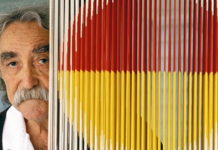Mateo Manaure
Artists should identify connections that allow them to establish goals and develop their sensitivity, reaffirm their confidence, broaden their humanism, multiply their aspirations, and transform their hopes into reality. These beliefs will make them more conscious of the universe around them and simultaneously nurture thoughts of beautiful utopias that will stimulate their creative process, and their desire to express contemporaneity in a dignified context.
Born in 1926 in Uracoa, Estado Monegas, Mateo Manaure is considered one of the leading exponents of mid-century Venezuelan geometric abstraction. Trained academically at the Escuela de Artes Plásticas in Caracas, Manaure’s early work reflected a more traditional approach to artmaking focusing on such classical genres as nudes, still lifes, and landscapes. But 1947 marked a decisive moment, awarded the prestigious Premio Nacional de Bellas Artes, Manaure soon departed for Paris where his paintings experienced a dramatic transformation, initially gravitating towards abstract surrealism and eventually embarking on a brief but dynamic abstract geometric phase. And, while his production witnessed a number of stylistic permutations in the ensuing years alternating between figuration and abstraction, the period from 1952-56 left an indelible mark on the history of Venezuelan abstract and vanguard art practices.
Manaure’s Parisian period also coincided with his seminal involvement with Los Disidentes (The Dissidents), a coalition of Venezuelan artists (active from 1945-50) that also included -Jesús Rafael Soto, Narciso Debourg, Alejandro Otero, Pascual Navarro, Herminy Perán, Rubén Núñez, Nena Palacios, J.M. Guillermos Péres, Alirio Oramas, Luis Guevara Moreno, Aime Battistini, Armando Barrios, Omar Carreño (refer to lot 222), and Carlos Gonzáles Bogen. Through their journal of the same name and their accompanying radical manifesto No (1950), Los Disidentes championed a progressive vision, that eschewed the conservative academicism embodied by the Escuela de Artes Plásticas and the Escuela Paisajista in Caracas, and in its place advocated for experimentation and geometric abstraction.
Upon his return to Caracas in 1952, Manaure set out in earnest to put these ideas into practice and found an immediate affinity with the modernist project unfolding so indicative of that era’s unprecedented growth and development. The latter was most evident in the architectural and public art works designed by the legendary modernist architect Carlos Raúl Villanueva, whose Cuidad Universitaria, the main campus of the Central University of Venezuela, is considered a landmark of city planning and architecture. Villanueva commissioned Manaure to execute several murals, painted wood reliefs, and stained glass windows for Cuidad Universitaria all reflective of the young artist’s newly adapted aesthetic. By 1956, the year both of these works were painted, Manaure was a leading figure of the abstractionist movement, exhibiting abroad at the Venice Biennial and locally at the Museo de Bellas Artes. Composicin No. 1 (the present lot) and Untitled (refer to lot 56) eloquently underscore Manaure’s approach to geometric abstraction. Here, the artist disrupts the modernist grid through trapezoidal planes, fragmented or broken lines, and asymmetrical spaces that rather than accentuate the rectilinear or rigid infuse his compositions with a kinetic power and lyrical sensibility. The poetic nuances of Manaure’s work are further ignited in Composicin No. 1 through his exhaustive exploration of the chromatic possibilities of black that he strategically highlights with notes of red and white, imbuing this work with a sense of depth and tension. In contrast Untitled is an exercise in controlled exuberance through the use of vibrant planes of red, yellow, green and black that suggests Manaure’s desire to evoke a sense of the local or regional amid the universal. The optimism embodied by this radical period would soon dissipate, and while Manaure remained active including returning to abstraction, most notably in the 1970s with his iconic Columnas Policromadas, his brief production during the 1950s would prove to be one of his most enduring and paradigmatic, fully engaged with his contemporaneity and the utopian ideals so emblematic of that moment.












